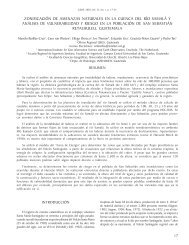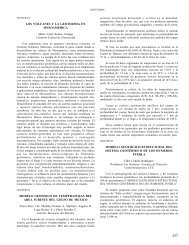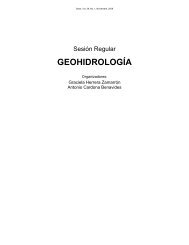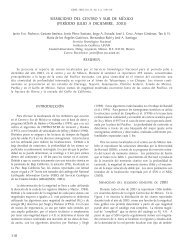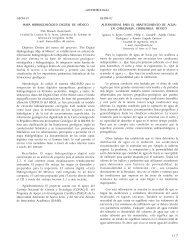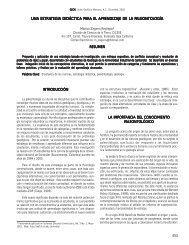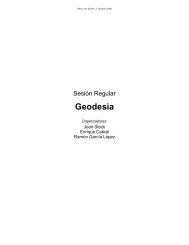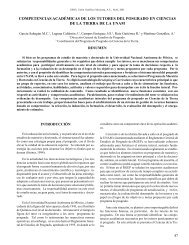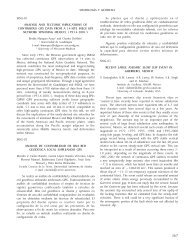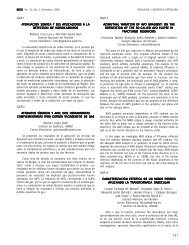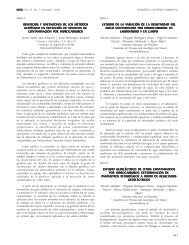GEOLOGÍA ESTRUCTURAL Y TECTÓNICA Geos, Vol. 31, No. 1, Noviembre, 2011centro que hacia los bor<strong>de</strong>s. Estos mecanismos actúan <strong>de</strong> manera combinadaen el Golfo <strong>de</strong> México, don<strong>de</strong> intervienen gran cantidad <strong>de</strong> factores como elespesor <strong>de</strong> la sal, la tasa <strong>de</strong> sedimentación y la inclinación <strong>de</strong>l basamento. Losresultados muestran que las dos formas para generar estos sistemas son: i) unacombinación <strong>de</strong> ambos mecanismos; ii) gravitational spreading, lo que favorecela formación y <strong>de</strong>sarrollo <strong>de</strong> estructuras como diapiros, pliegues <strong>de</strong> caja,pliegues <strong>de</strong> propagación <strong>de</strong> falla, canopies (toldos). A<strong>de</strong>más la <strong>de</strong>formación sepresenta por episodios, caracterizados por un incremento en el <strong>de</strong>splazamiento<strong>de</strong> las estructuras alternando con periodos <strong>de</strong> estabilidad <strong>de</strong>bido a la secuencianatural <strong>de</strong> formación <strong>de</strong> cabalgaduras. Los flujos tipo Couette y Poiseuilletambién se presentan <strong>de</strong> manera combinada, en el primero el flujo <strong>de</strong> sal tieneuna repercusión directa sobre la cobertura, mientras que en el segundo lainfluencia sobre el paquete sedimentario es menor.GET-16NUEVOS CRITERIOS <strong>AC</strong>ERCA DE LAS CAR<strong>AC</strong>TERÍSTICASSISMOGEODINÁMICAS DEL EXTREMO NORORIENTAL DE CUBAArango Arias Enrique Diego 1 , Vega Garriga Nicolás 2 , RíosMartínez Yamina 2 , Escobar Pérez Eric 2 y Álvarez Rivera Zulima 21 División <strong>de</strong> Ciencias <strong>de</strong> la Tierra, CICESE2 Centro Nacional <strong>de</strong> Investigaciones Sismológicas, Cubaearangoa@cicese.mxLa región <strong>de</strong>l nor<strong>de</strong>ste <strong>de</strong>l extremo oriental <strong>de</strong> Cuba ha manifestado <strong>de</strong>s<strong>de</strong> losaños 90 <strong>de</strong>l siglo pasado una actividad sísmica significativa con la ocurrencia<strong>de</strong> varias series <strong>de</strong> terremotos. Los parámetros <strong>de</strong>l mecanismo focal <strong>de</strong>l sismoocurrido el 28 <strong>de</strong> diciembre <strong>de</strong> 1998 con una magnitud <strong>de</strong> 5.4 en la escala<strong>de</strong> Richter se correspon<strong>de</strong>n con una falla inversa <strong>de</strong> bajo ángulo (22°) conun azimut <strong>de</strong> buzamiento <strong>de</strong> 200°. La interpretación <strong>de</strong> una red <strong>de</strong> perfilessísmicos profundos realizados en esta zona reflejan la existencia <strong>de</strong> unafalla transcortical. Coinci<strong>de</strong>ntemente con el trazado <strong>de</strong> esta falla, el mapagravimétrico <strong>de</strong> Bouguer <strong>de</strong> la parte norte <strong>de</strong>l Caribe manifiesta la existencia<strong>de</strong> una anomalía con mínimos negativos que continúan <strong>de</strong>s<strong>de</strong> el arco <strong>de</strong> lasAntillas menores y el norte <strong>de</strong> La Española.Todas las evi<strong>de</strong>ncias geodinámicas, geofísicas, morfotectónicas y sismológicaspermiten aseverar la continuidad al norte <strong>de</strong>l extremo oriental cubano <strong>de</strong> la fallaNorte <strong>de</strong> la Española, con un mecanismo predominante inverso y secundario <strong>de</strong><strong>de</strong>slizamiento por el rumbo siniestro, que provoca un proceso <strong>de</strong> infracorrimientomediante el cual la placa <strong>de</strong> Norteamérica choca y se introduce por <strong>de</strong>bajo <strong>de</strong>lbloque oriental cubano. La existencia <strong>de</strong> esta estructura tectónica explica <strong>de</strong>manera satisfactoria la génesis <strong>de</strong> la sismicidad que ocurrida al noreste <strong>de</strong> Moa.Este proceso es similar al <strong>de</strong>terminado por otros autores al norte <strong>de</strong> La Españolaen esta misma estructura tectónica y es la responsable <strong>de</strong> la sismicidad quegenera en toda la zona <strong>de</strong> norte <strong>de</strong>l Caribe don<strong>de</strong> han ocurrido sismos <strong>de</strong> hasta8.1 <strong>de</strong> magnitud Richter.GET-17 CARTELTHE THERMAL STRUCTURE OF DET<strong>AC</strong>HMENT FOLDSWITH SPECIAL EMPHASIS ON THE MISSISSIPPI FANFOLDBELT, NORTHEASTERN GULF OF MEXICOContreras Pérez Juan y Negrete Aranda RaquelDivisión <strong>de</strong> Ciencias <strong>de</strong> la Tierra, CICESEjuanc@pangea.cicese.mxWe present simple mo<strong>de</strong>ls for the steady-state thermal structure of <strong>de</strong>tachmentfolds. The mo<strong>de</strong>l uses a simplified mathematical <strong>de</strong>scription that incorporatesthe effects of heat conduction, heat advection by the folding process and thegeneration of heat by mechanical work as well as by the transmutation ofunstable isotopes. The mo<strong>de</strong>l ignores the effects of compaction and advectionof heat by superficial mass fluxes. Exact expressions for the heat flow andtemperature distribution insi<strong>de</strong> a <strong>de</strong>tachment fold are <strong>de</strong>rived for the case inwhich heat sources are negligible. A solution is further worked out for the casein which heat sources cannot be ignored.The mo<strong>de</strong>l’s analytical expressions show that as a <strong>de</strong>tachment fold contracts,material advection causes the heat flow passing across the core to drop andthe temperature to rise with respect to a constant-gradient temperature mo<strong>de</strong>l.The mo<strong>de</strong>l shows that this effect is amplified by the presence of heat sourcesand viscous dissipation. Analytical results also show that the <strong>de</strong>tachmentfold process <strong>de</strong>velops a thermal boundary layer. Conduction (diffusion) ofheat dominates insi<strong>de</strong> this boundary layer giving rise to a linear distributionof temperature insi<strong>de</strong> the layer. Advection (transport) of heat is the mainmechanism of heat flow outsi<strong>de</strong> the boundary layer. As a result the temperaturestrongly <strong>de</strong>viates from the linear trend.We tested our mo<strong>de</strong>l against a comprehensive database of boreholetemperatures available for the Gulf of Mexico thrusbelts, which are characterizedby a sharp bend at a <strong>de</strong>pth of 3 km. We find that the mo<strong>de</strong>l fits, within theuncertainty of the data, the borehole temperatures. Formerly the phenomenonwas thought to be the result of advection of heat by pore water, a conjecture thatlacks a firm physical basis.GET-18 CARTELMORPHOLOGY OF THE RIDGE-TRENCH COLLISION OFFCHAMELA, JALISCO: RESULTS OF THE MORTIC07 CAMPAIGNBandy William L. 1 , Mortera Gutiérrez Carlos 1 , Ortiz ZamoraGlicinia 2 , Ortega Ramírez José 3 , Ponce Núñez Francisco 4 ,Peláez Gaviria Juan Ramón 4 y Quintero <strong>de</strong> Leonardo Enrique 51 Instituto <strong>de</strong> Geofísica, UNAM2 CIS<strong>AC</strong>3 Instituto Nacional <strong>de</strong> Antropología e Historia4 Posgrado en Ciencias <strong>de</strong> la Tierra, UNAM5 Posgrado en Ciencias <strong>de</strong>l Mar y Limnología, UNAMbandy@geofisica.unam.mxIt is well established that the initiation of seafloor spreading along the East PacificRise has un<strong>de</strong>rgone a northward propagation, concurrent with a northwardpropagating cessation of seafloor spreading along the Mathematician Ridgeto the west. However, the northernmost point of this propagation is not wellestablished. One proposal, based on sparse, poorly navigated magnetic data,is that the EPR propagated northward of the present-day latitu<strong>de</strong> of the easternpart of the Rivera transform and colli<strong>de</strong>d with the Middle America Trench offChamela, Jalisco at about 1.5 Ma [Bandy, 1992]. Shortly after this collision, andpossibly as a result of the collision, spreading ceased along the ridge segmentlying north of the Rivera Transform. This hypothesis is supported by high-<strong>de</strong>nsitymarine magnetic data collected more recently during the MARTIC04, MARTIC05and MORTIC07 campaigns of the BO EL PUMA [Pelaez- Gaviria, 2008] andradiometric dating of a seafloor basalt sample obtained during MORTIC04[Schaaf et al., “High-Ti basalts from the Rivera Plate, western margin of Mexico:Petrology, Geochemistry, and Geochronology”, manuscript in preparation].In addition to magnetic data, during the MORTIC07 campaign (conducted inJanuary 2008), high-resolution bathymetric, seafloor backscatter imagery andhigh resolution seismic reflection data were collected in the region of the collision.The bathymetric data, previously unreported on, have been combined with datacollected previously during the BART and FAMEX campaigns of 2002 to revealthe <strong>de</strong>tailed morphology in and around the collision zone. In this talk we willpresent the results of an analysis of these data.GET-19 CARTELESTRUCTURA SOMERA EN EL PUNTO TRIPLE DE JALISCO REVISADAAlatorre Zamora Miguel Ángel, Pinzón López Juan Ignacio y Rosas Elguera JoséCentro Universitario <strong>de</strong> Ciencias Exactas e Ingenierías, UDGalatorre2004@hotmail.comLas características <strong>de</strong> una zona <strong>de</strong> alto interés académico y que registra pocacontroversia es la ubicación y estructura interna <strong>de</strong>l conocido como Punto Triple<strong>de</strong> Jalisco, o Punto Triple Jalisciense. Su ubicación relativamente exacta es<strong>de</strong>sconocida, a pesar <strong>de</strong> consistir en la unión <strong>de</strong> tres importantes rifts <strong>de</strong>lOcci<strong>de</strong>nte <strong>de</strong> México, esto es, los Rifts <strong>de</strong> Chapala (W-E), <strong>de</strong> Colima (N-S)y <strong>de</strong> Tepic-Zacoalco (NW-SE). El Rift <strong>de</strong> Colima separa a los <strong>de</strong>nominadosBloques <strong>de</strong> Jalisco y Michoacán, mientras que los otros dos rifts parecentener un fuerte compromiso con la formación <strong>de</strong>l Eje Neovolcánico o FajaVolcánica Transmexicana hacia esta región <strong>de</strong> México. La orientación, posicióny comportamiento <strong>de</strong> estos rifts si se ha prestado a cierta controversia, por lo quela posición <strong>de</strong> su unión resultaría también incierta. A<strong>de</strong>más, un cuarto sistema<strong>de</strong> fallas se ha consi<strong>de</strong>rado en juego, con la misma dirección <strong>de</strong>l rift Chapala,y al sur <strong>de</strong> este. Es el <strong>de</strong>nominado graben Citala, que parece formar parte <strong>de</strong>lentorno arquitectónico <strong>de</strong>l PTJ.Pocas investigaciones han prestado atención a esta unión triple; no obstante,muchos trabajos se han realizado sobre los rifts, con especial atención enfocadaal rift Tepic-Zacoalco, sobre todo para <strong>de</strong>finir el límite norte <strong>de</strong>l Bloque Jalisco.El rift Colima no ofrece muchas dudas acerca <strong>de</strong>l límite oriental; sin embargo,poco se ha tratado sobre el Punto Triple, e incluso es sumamente extraño quese mencione su ubicación. En suma, no hay estudios <strong>de</strong> ninguna índole sobrealgún carácter <strong>de</strong>l Punto Triple Jalisciense (Luhr et al., 1985; Allan et al., 1991).La lógica indica que la zona don<strong>de</strong> se encuentre influencia tectónica y estructural<strong>de</strong> los tres rifts sería la ubicación precisa <strong>de</strong>l PTJ. Sin embargo, fuera <strong>de</strong> éltambién podrían existir estructuras pertenecientes a los rifts.En este trabajo se ha elegido una zona como la más representativa <strong>de</strong> contenera la unión <strong>de</strong> los rifts, a aproximadamente 25 kms al sur <strong>de</strong> Guadalajara,don<strong>de</strong> confluyen las lagunas salobres <strong>de</strong> San Marcos y Zacoalco. El análisis<strong>de</strong> datos aeromagnéticos <strong>de</strong>l área don<strong>de</strong> se esperaría encontrar al PTJ hapermitido localizar estructuras <strong>de</strong> influencia mayor <strong>de</strong>l Rift Tepic-Zacoalco y,en menor medida, <strong>de</strong>l rift Chapala. Una <strong>de</strong>presión <strong>de</strong> profundidad no inferidaen el proceso <strong>de</strong>l análisis <strong>de</strong> los datos aeromagnéticos, localizada <strong>de</strong>bajo <strong>de</strong>lpoblado <strong>de</strong> Andrés Figueroa, podría indicar un punto ciego para la actividadtectónica <strong>de</strong> la zona. Esta <strong>de</strong>presión está bien marcada tanto por la señal50
Geos, Vol. 31, No. 1, Noviembre, 2011GEOLOGÍA ESTRUCTURAL Y TECTÓNICAanalítica como por el alineamiento <strong>de</strong> localizaciones obtenidas mediante lainversión <strong>de</strong> Euler. Los resultados arrojan una incipiente evolución <strong>de</strong>l PTJ haciael sur, hacia una posible segunda Unión Triple entre los rifts <strong>de</strong> Tepic-Zacoalco,<strong>de</strong> Colima y el graben <strong>de</strong> Citala. Algunas estructuras <strong>de</strong> interés para otra clase<strong>de</strong> estudios (ambientales, sísmicos) aparecen correlacionadas con fallas quetienen expresión superficial, como la que <strong>de</strong>limita la Sierra <strong>de</strong> San Marcos, condirección NW-SE.GET-20 CARTELANÁLISIS PRELIMINAR DEL ESTILO DE DEFORM<strong>AC</strong>IÓN DELCONGLOMERADO Z<strong>AC</strong>ATECAS DEL TERCIARIO INFERIORGarcía Sandoval Perla 1 , Escalona Alcázar Felipe <strong>de</strong> Jesús 1 ,Carrillo Castillo Carlos 1 , Escobedo Arellano Bianney 1 , NúñezPeña Ernesto Patricio 1 , Solari Luigi 2 y Bluhm Gutiérrez Jorge 11 Unidad Académica <strong>de</strong> Ciencias <strong>de</strong> la Tierra, UAZ2 Centro <strong>de</strong> Geociencias, UNAMperla_gasa@hotmail.comLos conglomerados continentales <strong>de</strong>l Terciario Temprano en México fueron<strong>de</strong>positados en fosas tectónicas que se <strong>de</strong>sarrollaron en la fase final <strong>de</strong> laOrogenia Larami<strong>de</strong>. Posteriormente, durante el Cenozoico, fueron <strong>de</strong>formadospor al menos cinco etapas <strong>de</strong> <strong>de</strong>formación extensional. Estos conglomeradoshan sido estudiados principalmente en Guanajuato y en Taxco; en el presentetrabajo se presentan los primeros resultados <strong>de</strong>l análisis estructural <strong>de</strong>lConglomerado Zacatecas.En el Conglomerado Zacatecas se tomaron datos estructurales, estratificacióny fallamiento, siguiendo la Regla <strong>de</strong> la Mano Derecha. Los planos <strong>de</strong>estratificación se midieron en las rocas sedimentarias y volcánicas que formana la unidad litológica en estudio. Los primeros resultados muestran que tienenechados menores a 15°, por lo que en un estereograma los polos <strong>de</strong> losplanos <strong>de</strong> estratificación se agrupan alre<strong>de</strong>dor <strong>de</strong> la vertical. Ocasionalmentehay datos con echados mayores, sin embargo, esto se <strong>de</strong>be a que hay <strong>de</strong>pósitospiroclásticos que se emplazaron en paleocanales.Las fallas tienen tres orientaciones preferentes que son hacia el NW-SE,NNE-SSW y NE-SW, en ese or<strong>de</strong>n <strong>de</strong> abundancia. A partir <strong>de</strong> las relaciones<strong>de</strong> corte observadas en el fallamiento se <strong>de</strong>finió que las estructuras orientadashacia el NW-SE se formaron primero que las NNE-SSW y NE-SW. La Veta LaCantera, <strong>de</strong> aproximadamente 7 km <strong>de</strong> longitud, es el rasgo estructural másgran<strong>de</strong> <strong>de</strong> rumbo NW-SE que, a<strong>de</strong>más, es el límite norte <strong>de</strong>l ConglomeradoZacatecas. En la parte central <strong>de</strong>l área <strong>de</strong> estudio hay al menos un par <strong>de</strong>estructuras <strong>de</strong> menor longitud con esta misma orientación que forman un horst.La Sierra <strong>de</strong> Zacatecas está limitada por segmentos <strong>de</strong> falla normal <strong>de</strong>rumbo preferente NNE-SSW. En el área <strong>de</strong> estudio algunas estructurascon esta orientación ponen en contacto tectónico al Grupo Zacatecas <strong>de</strong>lCretácico Inferior, con el Conglomerado Zacatecas <strong>de</strong>l Paleoceno-Eoceno. Estefallamiento forma bloques en dominó con echado al E que provocan en losestratos un basculamiento menor a 15° hacia el W.Las estructuras con orientación preferente hacia el NE-SW son escasas,probablemente están asociadas con las fallas principales, o bien se<strong>de</strong>sarrollaron por el cambio en la orientación <strong>de</strong> los paleoesfuerzos principalesdurante los diferentes eventos <strong>de</strong> <strong>de</strong>formación <strong>de</strong>l Cenozoico.Con los datos que se tienen y, consi<strong>de</strong>rando que este trabajo está iniciando, <strong>de</strong>forma preliminar se pue<strong>de</strong> <strong>de</strong>cir que no es claro que el Conglomerado Zacatecasse haya <strong>de</strong>positado en un graben orientado NW-SE. Los rasgos estructuralescon esta orientación están cortados por fallas <strong>de</strong> rumbo preferente NNE-SSW.La dispersión en la orientación <strong>de</strong> los ejes cinemáticos <strong>de</strong>l fallamiento sugiereque el Conglomerado Zacatecas registra otros eventos <strong>de</strong> <strong>de</strong>formación.A pesar <strong>de</strong> que el conglomerado presenta dos ó más eventos <strong>de</strong> <strong>de</strong>formación,los polos <strong>de</strong> los planos <strong>de</strong> estratificación son subverticales lo que sugiere quelas fallas principales tienen poco <strong>de</strong>splazamiento o bien que su echado essubvertical, la excepción posiblemente sea la Veta La Cantera.GET-21 CARTELINTERPRET<strong>AC</strong>IÓN CUALITATIVA DE LOS CAMPOS POTENCIALESREGIONALES DE LA CUENCA DE LA POPA, NE DE MÉXICOKrivosheya Konstantin, Yutsis Vsevolod y Tamez AntonioFacultad <strong>de</strong> Ciencias <strong>de</strong> la Tierra, UANLkvk@fct.uanl.mx<strong>de</strong>l sitio conocidas) y/o datos geológicos generales (los patrones <strong>de</strong> lasestructuras en general). Como resultado <strong>de</strong> la interpretación cualitativa <strong>de</strong> loscampos (observados, procesados, transformados) se trata obtener unos rasgosgenerales (cualitativos) <strong>de</strong>l mo<strong>de</strong>lo geológico.La técnica utilizada en este estudio <strong>de</strong> caso está basada en dosi<strong>de</strong>as principales: a) las estructuras superficiales generalmente se suce<strong>de</strong>nlas estructuras más profundas, b) diferentes campos potenciales y sustransformaciones distintas pue<strong>de</strong>n reflejar diferentes rasgos estructurales olas estructuras más profundas o más someras. La experiencia personalpue<strong>de</strong> servir: a) para reconocer correlaciones entre los campos y lasestructuras superficiales, b) para restaurar la continuación <strong>de</strong> las estructuras enprofundidad.Se han presentados los resultados <strong>de</strong> la interpretación conjunta cualitativa<strong>de</strong>l mapa geológico (1:250000), campo <strong>de</strong> gravedad, campo magnético <strong>de</strong>la cuenca <strong>de</strong> La Popa y sus alre<strong>de</strong>dores. La zonificación <strong>de</strong> los campospotenciales <strong>de</strong>l área <strong>de</strong>l estudio esta armonizada con las estructuras geológicasregionales, los elementos lineales pue<strong>de</strong>n ser interpretados como <strong>de</strong>limitación<strong>de</strong> los bloques corticales, etc. En su turno los resultados obtenidos pue<strong>de</strong>n sercorrelacionados con sismicidad o mineralización, por ejemplo.GET-22 CARTELPERFILES DE RADAR DE PENETR<strong>AC</strong>IÓN TERRESTRE COMOAPOYO EN LA INTERPRET<strong>AC</strong>IÓN ESTRUCTURAL DE LADEFORM<strong>AC</strong>IÓN EN EL FONDO DEL LAGO-CRÁTER DE RINCÓNDE PARANGUEO, VALLE DE SANTIAGO, GUANAJUATO, MÉXICORocha Treviño Luis, Cerca Martínez Mariano y Aranda Gómez José JorgeCentro <strong>de</strong> Geociencias, UNAMluisrot1205@gmail.comLa Hoya Rincón <strong>de</strong> Parangueo es uno <strong>de</strong> los cuatro maares que, con un escudo<strong>de</strong> lava continental y un domo volcánico, forman al Complejo Volcánico <strong>de</strong>Parangueo en la región septentrional <strong>de</strong> la Faja Volcánica Transmexicana.A partir <strong>de</strong> la <strong>de</strong>secación <strong>de</strong>l lago-cráter perenne <strong>de</strong> Rincón hacia los años1980’s, los sedimentos en el lecho <strong>de</strong>l lago experimentan una <strong>de</strong>formaciónmarcada asociada a su <strong>de</strong>splazamiento hacia el <strong>de</strong>pocentro. El rasgo mássobresaliente causado por la <strong>de</strong>formación es un escarpe topográfico que tieneun promedio <strong>de</strong> altura <strong>de</strong> 12 – 15 metros. Éste fue formado por un sistema<strong>de</strong> fallas normales con forma anular; otras estructuras notables asociadas alescarpe son grietas tensionales paralelas a la línea <strong>de</strong> costa <strong>de</strong>l lago y fracturasaproximadamente radiales respecto al <strong>de</strong>pocentro. En algunos sitios existentambién pliegues, con orientaciones y escalas diversas que <strong>de</strong>pen<strong>de</strong>n <strong>de</strong>su origen: sin-sedimentario (convoluted bedding ¿causado por <strong>de</strong>slizamientossubacuáticos?) o post-<strong>de</strong>secación asociados a tectónica gravitacional en lossedimentos lacustres. Entre los pliegues post-<strong>de</strong>secación se han documentadoestructuras asociadas a extensión, ya sea como pliegues por propagación <strong>de</strong>falla y pliegues roll-over en el bloque hundido al pie <strong>de</strong> las fallas lístricasprincipales. También se han cartografiado ca<strong>de</strong>nas <strong>de</strong> domos que se formaronpor sobrepresión, generada por el movimiento en masa <strong>de</strong> sedimentos <strong>de</strong>l bor<strong>de</strong>hacia el fondo <strong>de</strong>l lago en don<strong>de</strong>, <strong>de</strong>bajo <strong>de</strong> una capa seca y agrietada, existelodo que se <strong>de</strong>forma <strong>de</strong> manera dúctil.Para caracterizar la geometría somera <strong>de</strong> estas estructuras se utilizó un radar<strong>de</strong> penetración terrestre a lo largo <strong>de</strong> dos secciones <strong>de</strong> alre<strong>de</strong>dor <strong>de</strong> 1000 mc/u. Las secciones tienen rumbos aproximados NNW y WNW. Se empleó unequipo SIR 20 <strong>de</strong> GSSI, con una antena <strong>de</strong> 200 MHz con una permitividad <strong>de</strong>16. La profundidad estimada obtenida es #5 metros. Los perfiles se procesaroncon RADAN 6.6 y los resultados se corrigieron por topografía empleandoun mapa escala 1:2000 con curvas <strong>de</strong> nivel a un metro <strong>de</strong> separación.En este trabajo se presentan los perfiles que se consi<strong>de</strong>ran representativos<strong>de</strong> dos estilos <strong>de</strong> <strong>de</strong>formación contrastantes previamente documentados concartografía estructural <strong>de</strong>tallada. En la parte suroeste el escarpe es suave,con un ángulo <strong>de</strong> 18° y presenta fracturas verticales abiertas y superficies <strong>de</strong><strong>de</strong>spegues sub-horizontales y someras; adyacente al escarpe hay abultamientoligero hacia el <strong>de</strong>pocentro. El escarpe en el norte tiene un ángulo mayor (38°)y las fracturas son verticales con una separación promedio <strong>de</strong> un metro. En laparte oeste el escarpe se caracteriza por fallas lístricas y un pliegue que formaun abultamiento hacia el <strong>de</strong>pocentro.Hacia la parte central <strong>de</strong>l lago resaltan varios rasgos: 1) la conductividad <strong>de</strong>lmaterial aumenta notablemente por la concentración <strong>de</strong> sales solubles en aguay 2) se observan anomalías que sugieren la presencia <strong>de</strong> fallas normales (¿oconductos <strong>de</strong> escape <strong>de</strong> gas?) verticales que se cree relacionadas con ladisolución y remoción hacia el acuífero <strong>de</strong> las evaporitas en esa zona o con lapresencia <strong>de</strong> un sistema hidrotermal activo, respectivamente. Papiit IN-106307.El objetivo principal <strong>de</strong> un estudio geofísico es diseñar (restaurar) unmo<strong>de</strong>lo geológico <strong>de</strong> un sitio es <strong>de</strong>cir reconocer los rasgos o parámetros<strong>de</strong>l mo<strong>de</strong>lo. Los elementos principales <strong>de</strong> la metodología <strong>de</strong>l estudio sonobservación <strong>de</strong>l campo físico, procesado, interpretación cuantitativa (inversión)e interpretación cualitativa. Se supone que interpretación cualitativa es cualquieractividad personalizada <strong>de</strong> un geofísico la cual no pue<strong>de</strong> ser formalizadao computarizada. Naturalmente que este procedimiento está basado en laexperiencia profesional, datos geológicos externos particulares (las estructuras51
- Page 1 and 2:
Ortiz: Vientos Santa AnaVolumen 31N
- Page 3 and 4:
Geos, Vol. 31, No. 1, Noviembre, 20
- Page 5 and 6:
Geos, Vol. 31, No. 1, Noviembre, 20
- Page 7 and 8:
Geos, Vol. 31, No. 1, Noviembre, 20
- Page 9 and 10:
Geos, Vol. 31, No. 1, Noviembre, 20
- Page 11 and 12:
Geos, Vol. 31, No. 1, Noviembre, 20
- Page 13 and 14:
Geos, Vol. 31, No. 1, Noviembre, 20
- Page 15 and 16:
Geos, Vol. 31, No. 1, Noviembre, 20
- Page 17 and 18: Geos, Vol. 31, No. 1, Noviembre, 20
- Page 19 and 20: Geos, Vol. 31, No. 1, Noviembre, 20
- Page 21 and 22: Geos, Vol. 31, No. 1, Noviembre, 20
- Page 23 and 24: Geos, Vol. 31, No. 1, Noviembre, 20
- Page 25 and 26: Geos, Vol. 31, No. 1, Noviembre, 20
- Page 27 and 28: Geos, Vol. 31, No. 1, Noviembre, 20
- Page 29 and 30: Geos, Vol. 31, No. 1, Noviembre, 20
- Page 31 and 32: Geos, Vol. 31, No. 1, Noviembre, 20
- Page 33 and 34: Geos, Vol. 31, No. 1, Noviembre, 20
- Page 35 and 36: Geos, Vol. 31, No. 1, Noviembre, 20
- Page 37 and 38: Geos, Vol. 31, No. 1, Noviembre, 20
- Page 39 and 40: Geos, Vol. 31, No. 1, Noviembre, 20
- Page 41 and 42: Geos, Vol. 31, No. 1, Noviembre, 20
- Page 43 and 44: Geos, Vol. 31, No. 1, Noviembre, 20
- Page 45 and 46: Geos, Vol. 31, No. 1, Noviembre, 20
- Page 47 and 48: Geos, Vol. 31, No. 1, Noviembre, 20
- Page 49 and 50: Geos, Vol. 31, No. 1, Noviembre, 20
- Page 51 and 52: Geos, Vol. 31, No. 1, Noviembre, 20
- Page 53 and 54: Geos, Vol. 31, No. 1, Noviembre, 20
- Page 55 and 56: Geos, Vol. 31, No. 1, Noviembre, 20
- Page 57 and 58: Geos, Vol. 31, No. 1, Noviembre, 20
- Page 59 and 60: Geos, Vol. 31, No. 1, Noviembre, 20
- Page 61 and 62: Geos, Vol. 31, No. 1, Noviembre, 20
- Page 63 and 64: Geos, Vol. 31, No. 1, Noviembre, 20
- Page 65 and 66: Geos, Vol. 31, No. 1, Noviembre, 20
- Page 67: Geos, Vol. 31, No. 1, Noviembre, 20
- Page 71 and 72: Geos, Vol. 31, No. 1, Noviembre, 20
- Page 73 and 74: Geos, Vol. 31, No. 1, Noviembre, 20
- Page 75 and 76: Geos, Vol. 31, No. 1, Noviembre, 20
- Page 77 and 78: Geos, Vol. 31, No. 1, Noviembre, 20
- Page 79 and 80: Geos, Vol. 31, No. 1, Noviembre, 20
- Page 81 and 82: Geos, Vol. 31, No. 1, Noviembre, 20
- Page 83 and 84: Geos, Vol. 31, No. 1, Noviembre, 20
- Page 85 and 86: Geos, Vol. 31, No. 1, Noviembre, 20
- Page 87 and 88: Geos, Vol. 31, No. 1, Noviembre, 20
- Page 89 and 90: Geos, Vol. 31, No. 1, Noviembre, 20
- Page 91 and 92: Geos, Vol. 31, No. 1, Noviembre, 20
- Page 93 and 94: Geos, Vol. 31, No. 1, Noviembre, 20
- Page 95 and 96: Geos, Vol. 31, No. 1, Noviembre, 20
- Page 97 and 98: Geos, Vol. 31, No. 1, Noviembre, 20
- Page 99 and 100: Geos, Vol. 31, No. 1, Noviembre, 20
- Page 101 and 102: Geos, Vol. 31, No. 1, Noviembre, 20
- Page 103 and 104: Geos, Vol. 31, No. 1, Noviembre, 20
- Page 105 and 106: Geos, Vol. 31, No. 1, Noviembre, 20
- Page 107 and 108: Geos, Vol. 31, No. 1, Noviembre, 20
- Page 109 and 110: Geos, Vol. 31, No. 1, Noviembre, 20
- Page 111 and 112: Geos, Vol. 31, No. 1, Noviembre, 20
- Page 113 and 114: Geos, Vol. 31, No. 1, Noviembre, 20
- Page 115 and 116: Geos, Vol. 31, No. 1, Noviembre, 20
- Page 117 and 118: Geos, Vol. 31, No. 1, Noviembre, 20
- Page 119 and 120:
Geos, Vol. 31, No. 1, Noviembre, 20
- Page 121 and 122:
Geos, Vol. 31, No. 1, Noviembre, 20
- Page 123 and 124:
Geos, Vol. 31, No. 1, Noviembre, 20
- Page 125 and 126:
Geos, Vol. 31, No. 1, Noviembre, 20
- Page 127 and 128:
Geos, Vol. 31, No. 1, Noviembre, 20
- Page 129 and 130:
Geos, Vol. 31, No. 1, Noviembre, 20
- Page 131 and 132:
Geos, Vol. 31, No. 1, Noviembre, 20
- Page 133 and 134:
Geos, Vol. 31, No. 1, Noviembre, 20
- Page 135 and 136:
Geos, Vol. 31, No. 1, Noviembre, 20
- Page 137 and 138:
Geos, Vol. 31, No. 1, Noviembre, 20
- Page 139 and 140:
Geos, Vol. 31, No. 1, Noviembre, 20
- Page 141 and 142:
Geos, Vol. 31, No. 1, Noviembre, 20
- Page 143 and 144:
Geos, Vol. 31, No. 1, Noviembre, 20
- Page 145 and 146:
Geos, Vol. 31, No. 1, Noviembre, 20
- Page 147 and 148:
Geos, Vol. 31, No. 1, Noviembre, 20
- Page 149 and 150:
Geos, Vol. 31, No. 1, Noviembre, 20
- Page 151 and 152:
Geos, Vol. 31, No. 1, Noviembre, 20
- Page 153 and 154:
Geos, Vol. 31, No. 1, Noviembre, 20
- Page 155 and 156:
Geos, Vol. 31, No. 1, Noviembre, 20
- Page 157 and 158:
Geos, Vol. 31, No. 1, Noviembre, 20
- Page 159 and 160:
Geos, Vol. 31, No. 1, Noviembre, 20
- Page 161 and 162:
Geos, Vol. 31, No. 1, Noviembre, 20
- Page 163 and 164:
Geos, Vol. 31, No. 1, Noviembre, 20
- Page 165 and 166:
Geos, Vol. 31, No. 1, Noviembre, 20
- Page 167 and 168:
Geos, Vol. 31, No. 1, Noviembre, 20
- Page 169 and 170:
Geos, Vol. 31, No. 1, Noviembre, 20
- Page 171 and 172:
Geos, Vol. 31, No. 1, Noviembre, 20
- Page 173 and 174:
Geos, Vol. 31, No. 1, Noviembre, 20
- Page 175 and 176:
Geos, Vol. 31, No. 1, Noviembre, 20
- Page 177 and 178:
Geos, Vol. 31, No. 1, Noviembre, 20
- Page 179 and 180:
Geos, Vol. 31, No. 1, Noviembre, 20
- Page 181 and 182:
Geos, Vol. 31, No. 1, Noviembre, 20
- Page 183 and 184:
Geos, Vol. 31, No. 1, Noviembre, 20
- Page 185 and 186:
Geos, Vol. 31, No. 1, Noviembre, 20
- Page 187 and 188:
Geos, Vol. 31, No. 1, Noviembre, 20
- Page 189 and 190:
Geos, Vol. 31, No. 1, Noviembre, 20
- Page 191 and 192:
Geos, Vol. 31, No. 1, Noviembre, 20
- Page 193 and 194:
Geos, Vol. 31, No. 1, Noviembre, 20
- Page 195 and 196:
Geos, Vol. 31, No. 1, Noviembre, 20
- Page 197 and 198:
Geos, Vol. 31, No. 1, Noviembre, 20
- Page 199 and 200:
Geos, Vol. 31, No. 1, Noviembre, 20
- Page 201 and 202:
Geos, Vol. 31, No. 1, Noviembre, 20
- Page 203 and 204:
Geos, Vol. 31, No. 1, Noviembre, 20
- Page 205 and 206:
Geos, Vol. 31, No. 1, Noviembre, 20
- Page 207 and 208:
Geos, Vol. 31, No. 1, Noviembre, 20
- Page 209 and 210:
Geos, Vol. 31, No. 1, Noviembre, 20
- Page 211 and 212:
Geos, Vol. 31, No. 1, Noviembre, 20
- Page 213 and 214:
Geos, Vol. 31, No. 1, Noviembre, 20
- Page 215 and 216:
Geos, Vol. 31, No. 1, Noviembre, 20
- Page 217 and 218:
Geos, Vol. 31, No. 1, Noviembre, 20
- Page 219 and 220:
Geos, Vol. 31, No. 1, Noviembre, 20
- Page 221 and 222:
Recordamos a todos los miembros de



![Libro de resúmenes [revisión final, 172 páginas] - UGM](https://img.yumpu.com/51565067/1/190x245/libro-de-resamenes-revisian-final-172-paginas-ugm.jpg?quality=85)
